
Siddhartha Gautama, most commonly referred to as the Buddha, was a wandering ascetic and religious teacher who lived in South Asia during the 6th or 5th century BCE and founded Buddhism.

Hārītī (Sanskrit), also known as Chinese: 鬼子母(神); pinyin: Guǐzǐmǔ(shén), Japanese: 鬼子母神, romanized: Kishimojin, is both a revered goddess and demon, depending on the Buddhist tradition. She is one of the Twenty-Four Protective Deities of Mahayana Buddhism.
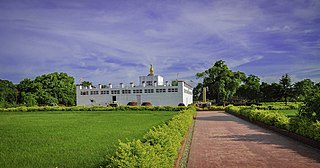
Lumbinī is a Buddhist pilgrimage site in the Rupandehi District of Lumbini Province in Nepal. It is the place where, according to Buddhist tradition, queen Maya gave birth to Siddhartha Gautama at around 566 BCE. Gautama, who, according to Buddhist tradition, achieved Enlightenment some time around 528 BCE, became Shakyamuni Buddha and founded Buddhism. Lumbini is one of many magnets for pilgrimage that sprang up in places pivotal to the life of the Buddha.

Maitreya or Metteyya, also Maitreya Buddha or Metteyya Buddha, is regarded as the future Buddha of this world in Buddhist eschatology. As the fifth and final Buddha of the current kalpa, Maitreya's teachings will be focused around re-establishing the dharma, a vital concept in Hinduism, Buddhism, and Jainism.

Bulguksa (Korean: 불국사) is a Buddhist temple on Tohamsan, in Jinheon-dong, Gyeongju, North Gyeongsang Province, South Korea.

Nichiren Shū is a combination of several schools ranging from four of the original Nichiren Buddhist schools that date back to Nichiren's original disciples, and part of the fifth:
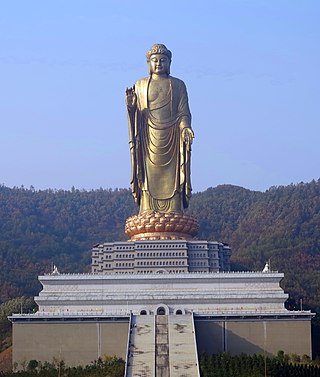
Vairocana is a cosmic buddha from Mahayana and Vajrayana Buddhism. Vairocana is often interpreted, in texts like the Avatamsaka Sutra, as the dharmakāya of the historical Gautama Buddha. In East Asian Buddhism, Vairocana is also seen as the embodiment of the Buddhist concept of śūnyatā. In the conception of the 5 Jinas of Mahayana and Vajrayana Buddhism, Vairocana is at the centre and is considered a Primordial Buddha.

The Seokguram Grotto (Korean: 석굴암) is a hermitage and part of the Bulguksa temple complex in Gyeongju, South Korea. It and Bulguksa are both on the mountain Tohamsan, although the two are separated by distance of around 3 kilometres (1.9 mi). The grotto overlooks the Sea of Japan and rests 750 meters above sea level. In 1962, it was designated the 24th National Treasure of South Korea. In 1995, Seokguram was added to the UNESCO World Heritage List together with the Bulguksa Temple. It exemplifies some of the best Buddhist sculptures in the world.
A Buddhist chant is a form of musical verse or incantation, in some ways analogous to religious recitations of other faiths.

Dipankara or Dipankara Buddha is one of the Buddhas of the past. He is said to have lived on Earth four asankheyyas and one hundred thousand kappas ago. According to some Buddhist or folk traditions, Dipankara was a previous Buddha who attained Enlightenment eons prior to Gautama Buddha, the historical Buddha.

Samantabhadra is a great bodhisattva in Buddhism associated with practice and meditation. Together with Shakyamuni Buddha and the bodhisattva Mañjuśrī, he forms the Shakyamuni Triad in Mahayana Buddhism. He is the patron of the Lotus Sutra and, according to the Avatamsaka Sutra, made the ten great vows which are the basis of a bodhisattva. In Chinese Buddhism, Samantabhadra is known as Pǔxián and is associated with action, whereas Mañjuśrī is associated with prajñā. In Japan, this bodhisattva is known as Fugen, and is often venerated in Tendai and Shingon Buddhism.
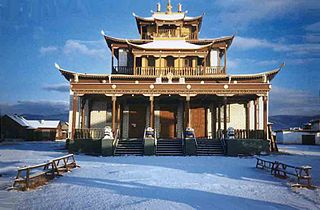
Datsan is the term used for Buddhist university monasteries in the Tibetan tradition of Gelukpa located throughout Mongolia, Tibet and Siberia. As a rule, in a datsan there are two departments—philosophical and medical. Sometimes a department of tantric practices is added to them where the monks study only after finishing education in the philosophical department.
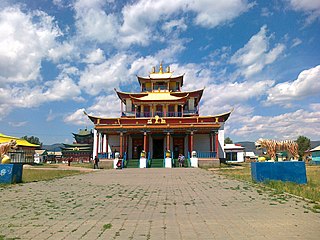
Ivolginsky Datsan is the center of the Buddhist Traditional Sangha of Russia. It is a Buddhist temple located in Buryatia, Russia, 23 km from Ulan Ude, near Verkhnyaya Ivolga village.

The Three Ages of Buddhism, also known as the Three Ages of the Dharma, are three divisions of time following Shakyamuni Buddha's death and passing into Nirvana in East Asian Buddhism.

Historically, Buddhism was incorporated into Siberia in the early 17th century. Buddhism is considered to be one of Russia's traditional religions and is legally a part of Russian historical heritage. Besides the historical monastic traditions of Buryatia, Tuva and Kalmykia, the religion of Buddhism is now spreading all over Russia, with many ethnic Russian converts.
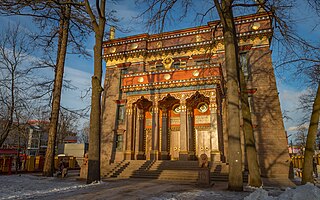
The Datsan Gunzechoinei is a large Buddhist temple in Saint Petersburg, Russia. It is the northernmost Buddhist temple in Russia.
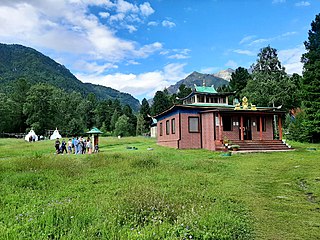
Arshan is a small resort village in the Tunkinsky District, Republic of Buryatia, Russian Federation. It is known for its mineral waters, spa, and the Khoymorski Datsan Boddhidharma Tibetan Buddhist temple. The name comes from the Buryat word for "spring."

Buddhism in Buryatia, a region in Siberia, Russia, has a deep-rooted history dating back to the 17th century when Tibetan Buddhism first arrived in the area. Initially adopted by ethnic groups like the Selenga and Zede Buryats, Buddhism gradually spread throughout the Transbaikal region. In 1741, it gained formal recognition as an official religion in the Russian Empire, with the establishment of Buddhist monastic universities known as datsans. Despite facing significant challenges during the Soviet era, including persecution and the closure of religious institutions, Buddhism in Buryatia has persisted and experienced a revival in the post-Soviet period.
The Texas Buddhist Association is a non-profit nondenominational religious organization committed to providing religious ceremonies and educational programs and serving the community. Not distinguishing between different sects of Buddhism, TBA places an emphasis on spreading the right views of the Dharma. The mission statement is to adopt and practice Buddha's teachings of loving kindness, compassion, joyfulness, and serenity in our daily lives for the benefit of ourselves and others; and to cultivate the wisdom necessary for clear understanding of both the universe and the human spirit. With multiple monastics and a large lay congregation, TBA is now one of the largest Buddhist associations in the United States, with its 515-acre American Bodhi Center in Waller County, Texas one of the largest by area Buddhist facilities in the country, comparable with the nearby 500 acre Chung Tai International Retreat Center Texas Pagoda Chan Monastery in Shepherd, Texas, the 400 acre Deer Park Monastery in Escondido, California, and the 700 acres of the City of Ten Thousand Buddhas in Ukiah, California.

According to the Mahāparinibbāṇa Sutta, after attaining parinirvana, the body of Buddha was cremated and the ashes divided among his lay followers.



















